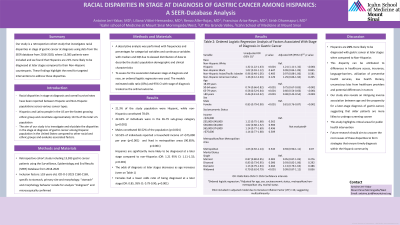Monday Poster Session
Category: Stomach
P3321 - Disparities in Stage at Diagnosis Among Hispanics/Latinxs with Gastric Cancer in the United States: A Population-Based Study
Monday, October 28, 2024
10:30 AM - 4:00 PM ET
Location: Exhibit Hall E

Has Audio

Antoine Jeri-Yabar, MD
Icahn School of Medicine at Mount Sinai Morningside/West
Manhattan, NY
Presenting Author(s)
Antoine Jeri-Yabar, MD1, Liliana Vittini-Hernandez, MD2, Renzo Aller-Rojas, MD3, Francisco Arias-Reyes, MD3, Sirish Dharmapuri, MD4
1Icahn School of Medicine at Mount Sinai Morningside/West, Manhattan, NY; 2Mount Sinai Beth Israel, Icahn School of Medicine at Mount Sinai, Manhattan, NY; 3University of Texas Rio Grande Valley, McAllen, TX; 4Icahn School of Medicine at Mount Sinai, New York, NY
Introduction: Racial disparities in stage at diagnosis, treatment and overall survival rates have been reported between Hispanic and non-Hispanic populations across various cancer types. Despite being classified as a low-incidence country for gastric cancer, the U.S sees approximately 26,000 new diagnoses each year. The purpose of this study is to evaluate disparities in the stage of gastric cancer at diagnosis among different racial groups and evaluate associated demographic factors.
Methods: Using the SEER database spanning from 2000 to 2020, a retrospective cohort study of 13,383 gastric cancer patients was conducted. Selection of the population based on the ICD-O-3 2023 revision with primary site and morphology of “stomach” and site and morphology behavior recode for analysis “malignant”. Patients with incomplete data on our independent variables were excluded from the analysis. Ordered logistic regression was used to study the association between the race and the stage of gastric cancer at diagnosis.
Results: 21.3% of the study population were Hispanic, while non-Hispanics constituted 78.6%. 42.62% of individuals were in the 65-79 years sub-group category (p< 0.001). Males constituted 60.52% of the population (p< 0.001). 59.25% of the individuals included reported a household income of >$75,000 (p< 0.001). The majority lived in Metropolitan areas (90.85%) (p< 0.001). Most patients were married (62.65%) (p< 0.001) and were diagnosed at stage IV (33.38%) (p< 0.001). Hispanics are significantly more likely to be diagnosed at a later stage compared to non-Hispanics (OR: 1.21 95% CI: 1.11-1.32; p< 0.001). The odds of diagnosis at later stages decreases as age increases. Females had a lower odds ratio of being diagnosed at a later stage (OR: 0.85 95% CI: 0.79-0.90; p< 0.001).
Discussion: Hispanics are 21% more likely to be diagnosed of gastric cancer at later stages when compared to non-Hispanics. This could be attributed to differences in healthcare access, insurance, language-barriers, utilization of preventive health services, low health literacy, unconscious bias from healthcare providers and potential differences in tumors which highlight critical areas for public health intervention aimed at reducing disparities through improved awareness campaigns and access to healthcare.
Note: The table for this abstract can be viewed in the ePoster Gallery section of the ACG 2024 ePoster Site or in The American Journal of Gastroenterology's abstract supplement issue, both of which will be available starting October 27, 2024.
Disclosures:
Antoine Jeri-Yabar, MD1, Liliana Vittini-Hernandez, MD2, Renzo Aller-Rojas, MD3, Francisco Arias-Reyes, MD3, Sirish Dharmapuri, MD4. P3321 - Disparities in Stage at Diagnosis Among Hispanics/Latinxs with Gastric Cancer in the United States: A Population-Based Study, ACG 2024 Annual Scientific Meeting Abstracts. Philadelphia, PA: American College of Gastroenterology.
1Icahn School of Medicine at Mount Sinai Morningside/West, Manhattan, NY; 2Mount Sinai Beth Israel, Icahn School of Medicine at Mount Sinai, Manhattan, NY; 3University of Texas Rio Grande Valley, McAllen, TX; 4Icahn School of Medicine at Mount Sinai, New York, NY
Introduction: Racial disparities in stage at diagnosis, treatment and overall survival rates have been reported between Hispanic and non-Hispanic populations across various cancer types. Despite being classified as a low-incidence country for gastric cancer, the U.S sees approximately 26,000 new diagnoses each year. The purpose of this study is to evaluate disparities in the stage of gastric cancer at diagnosis among different racial groups and evaluate associated demographic factors.
Methods: Using the SEER database spanning from 2000 to 2020, a retrospective cohort study of 13,383 gastric cancer patients was conducted. Selection of the population based on the ICD-O-3 2023 revision with primary site and morphology of “stomach” and site and morphology behavior recode for analysis “malignant”. Patients with incomplete data on our independent variables were excluded from the analysis. Ordered logistic regression was used to study the association between the race and the stage of gastric cancer at diagnosis.
Results: 21.3% of the study population were Hispanic, while non-Hispanics constituted 78.6%. 42.62% of individuals were in the 65-79 years sub-group category (p< 0.001). Males constituted 60.52% of the population (p< 0.001). 59.25% of the individuals included reported a household income of >$75,000 (p< 0.001). The majority lived in Metropolitan areas (90.85%) (p< 0.001). Most patients were married (62.65%) (p< 0.001) and were diagnosed at stage IV (33.38%) (p< 0.001). Hispanics are significantly more likely to be diagnosed at a later stage compared to non-Hispanics (OR: 1.21 95% CI: 1.11-1.32; p< 0.001). The odds of diagnosis at later stages decreases as age increases. Females had a lower odds ratio of being diagnosed at a later stage (OR: 0.85 95% CI: 0.79-0.90; p< 0.001).
Discussion: Hispanics are 21% more likely to be diagnosed of gastric cancer at later stages when compared to non-Hispanics. This could be attributed to differences in healthcare access, insurance, language-barriers, utilization of preventive health services, low health literacy, unconscious bias from healthcare providers and potential differences in tumors which highlight critical areas for public health intervention aimed at reducing disparities through improved awareness campaigns and access to healthcare.
Note: The table for this abstract can be viewed in the ePoster Gallery section of the ACG 2024 ePoster Site or in The American Journal of Gastroenterology's abstract supplement issue, both of which will be available starting October 27, 2024.
Disclosures:
Antoine Jeri-Yabar indicated no relevant financial relationships.
Liliana Vittini-Hernandez indicated no relevant financial relationships.
Renzo Aller-Rojas indicated no relevant financial relationships.
Francisco Arias-Reyes indicated no relevant financial relationships.
Sirish Dharmapuri indicated no relevant financial relationships.
Antoine Jeri-Yabar, MD1, Liliana Vittini-Hernandez, MD2, Renzo Aller-Rojas, MD3, Francisco Arias-Reyes, MD3, Sirish Dharmapuri, MD4. P3321 - Disparities in Stage at Diagnosis Among Hispanics/Latinxs with Gastric Cancer in the United States: A Population-Based Study, ACG 2024 Annual Scientific Meeting Abstracts. Philadelphia, PA: American College of Gastroenterology.
